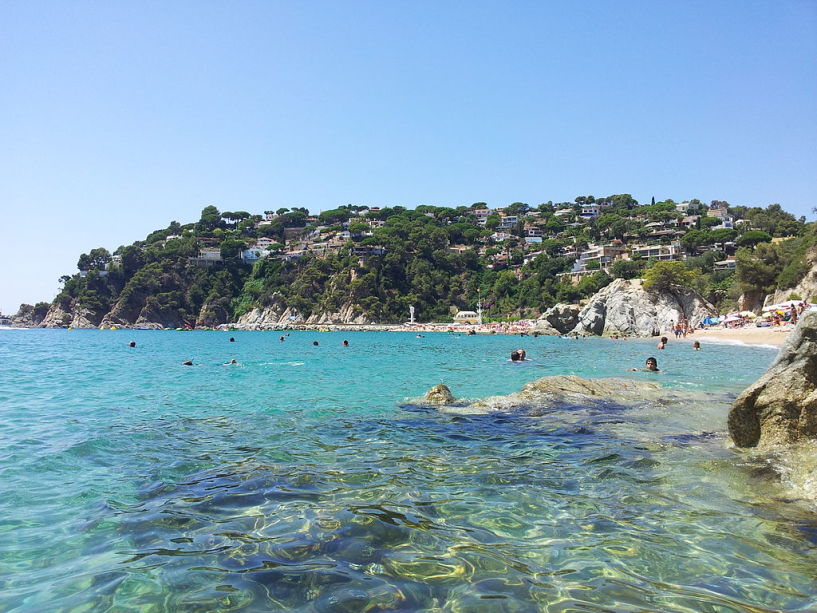You’re likely familiar with the beaches and bars of Lloret de Mar, since it’s an enduringly popular destination for those looking for a warm, relaxing summer holiday, and its main beach is Blue Flag-clean. By all means enjoy the sun, relax on the beach and swim in that gorgeous blue sea, but it’d be a crying shame to miss out on the architectural wonders scattered throughout the city.
The Parish Church of Sant Roma
Probably the most famous of Lloret de Mar’s buildings, Sant Roma is quite something to behold. It began as a gothic church in the sixteenth century and remained as such until the modernists of the 20th century festooned the old building with domes and spires, all decorated with multicoloured mosaics.
Bearing testament to the city’s strong Indiano influence (the Indianos were emigrés who, having travelled to the Americas and made their fortune, then returned to spend it in Spain), either one of the gothic church or the modernist additions would make this a spot worth a visit, but the contrast between them is sublime.
Modernist Cemetery
Also courtesy of the Indianos’ wealth comes the city’s modernist cemetery. The tombs, mausolea and gravestones make for a splendidly chaotic display, rising up like a stone forest memorialising the dead. The variation between the designs of the various tombs and the imagination shown therein are both stunning, with the rounded edges and intricate detail showing a strong Gaudi influence.
Both the vast magnificence of the cemetery and the uniqueness of each one of its tombs make this an excellent spot to visit. The riotous grandeur of the sculptures also makes a pleasant change from the sombre atmosphere common to many cemeteries.
[mapsmarker marker=”46″]
Traditional Architecture
For a less bizarre but still impressive architectural experience, try visiting one of the city’s various colonial, neogothic or neoclassical buildings. You’ll likely pass the neoclassical town hall during your holiday, and Can Saragasso is an ex-farmhouse whose narrow windows, gargoyles and statues bespeak a gothic influence. You may also want to visit the understated yet attractive Chapel of Santa Cristina, built in the 18th century, and spend some time wandering the city to see what else you might stumble across.
Contemporary Architecture
While not usually high on the list for architectural value in holiday destinations, Lloret de Mar nonetheless boasts some excellent examples of contemporary architecture. After the fluid intricacy of the modernist cemetery and the gothic pomp of some of the city’s historic buildings, the clean-cut angularity of the city’s cultural centre and the glass-fronted minimalism of the Lloret de Mar theatre can provide a refreshing contrast.
How to get to Lloret de Mar
Planes usually land at either Barcelona airport or Girona airport. Direct buses run from Girona to Lloret de Mar, taking around 45 minutes. If you’re landing at Barcelona, it’s approximately a two hour bus journey, changing at Girona. You can also pre-book a Barcelona airport shuttle with us to save you time waiting for public transport links.
To reach Lloret de Mar by train, you’ll have to first travel to Barcelona (reachable through various major train routes from Spanish and other European cities). From here it’s a little over two hours on the train to Blanes, and then a bus runs every half an hour to Lloret de Mar, taking only fifteen minutes.
[mapsmarker marker=”6″]
Where to stay
Hostal Mary – Only a five minute walk from the beach and a stone’s throw from the bus station, Hostal Mary offers unbeatable convenience at an excellent price. Perfect for anyone seeking simple, no-frills budget accommodation in a central location, Hostal Mary also serves food and has somebody on the desk at all hours.
Hotel la Palmera & Spa – If you plan to spend slightly more time in your hotel, then consider Hotel la Palmera. Its location is similar to that of Hostal Mary, being within a five minute walk of both the main beach and the bus station, but La Palmera also offers a fully-equipped spa and outdoor pool, which is valuable if the beach is looking especially crowded.
Hotel Santa Marta – For a slightly more upmarket hotel experience, look no further than Hotel Santa Marta. It’s more secluded than the other hotels, offering the prospect of a quiet escape into the 14 acres of surrounding wooded countryside after a day spent sightseeing. In addition to its peaceful location, beside Santa Cristina beach, the Santa Marta offers all the luxuries you’d expect of a five star hotel.




